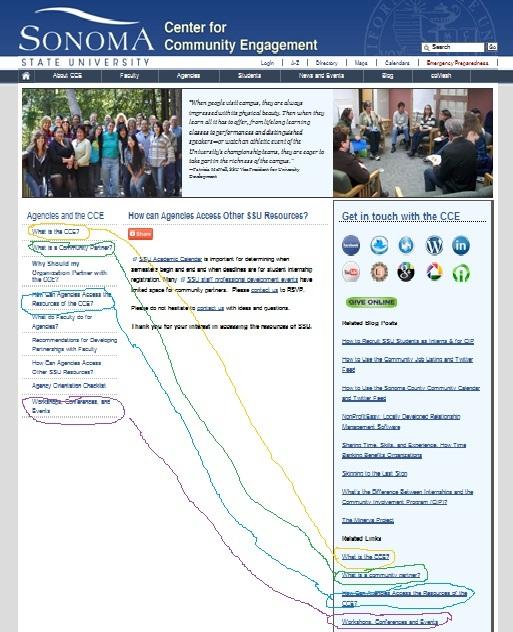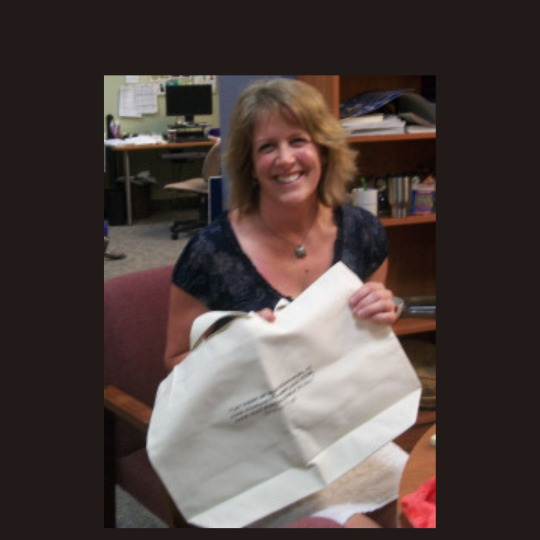Reflections on Being a Community Partner
Last semester, the CCE had the great pleasure of serving as a community partner to a pair of excellent Santa Rosa Junior College service-learners. Service-learning is a pedagogy, or teaching method, that utilizes community service projects within the context of an academic course. Students are expected to use the service as a text for their class, so that they learn the content of the class through experience. They are also expected to collaborate with a nonprofit or governmental agency and reflect on how doing so not only impacts their academic learning, but their civic learning. Finally, they are expected to have a positive impact on their community partner's mission and/or operations. Supporting service-learning is central to our mission and a professional and functional website is imperative for operations.
As part of their CS 50.31/CS 50.32 Business of Web Design class Carolyn Warren ([email protected]) and Lisa Glover did the much-needed and extremely challenging work of overhauling the CCE website. The CCE's new site is launching later this week and we're really excited about it. But we weren't the only ones to benefit. The students learned a lot both about web design and from working with a mission-focused organization. "The most important things that I learned were the soft skills of communication, time management, and teamwork. I also learned the hard skills of working with Dreamweaver and the nuts and bolts of building a website. Because it's a big site and it's so intricate, I came to appreciate the complexity of the CCE and the work done there." Carolyn explained.
I'm guessing they really didn't know what they were getting into, and I greatly appreciate all they did for the CCE and for me personally. Serving as a community partner provided me with some important personal and professional lessons.
This all started several years ago when I heard rumors of amazing SRJC students developing websites for local nonprofit organizations. In fact, I mentioned this resource in a blog post last summer. Then three years ago, I saw a posting on the Latino Service Providers listserv and considered applying. I was well aware of how outdated and challenging to navigate our site is and was finding myself increasingly embarrassed by it. I was informed that SSU was planning a University-wide overhaul of all websites with new templates and support and that moving forward on my own could be a waste of resources. A year passed and when the posting came up again, I decided to apply. I filled out and submitted multiple forms, some with redundancies. I never heard anything so when the semester was well underway, I assumed I'd been rejected. I didn't know how decisions were made and if there was anything I could do to improve my application. So when this year's post appeared, I made virtually no changes and re-submitted. I was thrilled to get the email telling me my project had been selected.
My persistence had paid off, but then the work really began. The instructor's application paperwork warned all the clients that virtually all past clients had underestimated the amount of work they would have to do. This turned out to be absolutely correct in my case. I spent several weekends and many nights writing, reviewing and communicating with Carolyn and Lisa. Due to the extreme time constraints of the semester schedule, we worked hard to make every deadline. As a service-learning professional, I'm aware that the challenge of the differing schedules of the academic and "real world" is often the greatest concern that community partners share about service-learning. That this was also a challenge for me, from within academia, was an irony that I did not miss. I have to assume that this was even more challenging for the other clients.
Another irony is how rare it is for service-learning professionals to take on the community partner role. Occasionally we work with service-learners from our own campuses, with whom we may have a different level of real or perceived authority than other community partners. But most of the time, we espouse the value of experiential education, while rarely participating in any of our own for professional development purposes. Generally, we facilitate other partnerships and keep up with research on partnerships, so serving as a community partner was a rare, authentic professional development experience for me.
Best practices in service-learning and studies of the experiences of community partners encourage a strong relationship between the community partner and the instructor. But I didn't even meet the instructor until the last day of class when the students presented their projects. In fact, throughout the experience, neither their instructor nor the students referred to themselves as service-learners or to me as a community partner. I was the "client."

It seems obvious, but I couldn’t “see” it until I “saw” it.
But we functioned more like a team. "The new CCE website would not have been possible without the complete collaboration we shared amongst
us. Our "client" was our teammate; a teammate whose contributions were invaluable. The three of us worked together with a great synergy, functioning as well as the three legs of a milking stool," said Lisa. In fact, at the class presentation, Lisa and Carolyn insisted that unlike the other student presenters, I go with them to present. It was an honor to serve in this way and I felt that I both got an excellent product and contributed to the students' learning; a mark of a true partnership.
I personally enjoyed the lesson in humility that I gained from working with Carolyn and Lisa. Because I'm the only professional staff member in my office, I'm accustomed to getting my way with day-to-day decisions. With this project, I compromised again and again. I am not a visual person and have learned to trust others' guidance in this area. Additionally, the technological requirements and University rules are well beyond my knowledge base, so I also took a backseat role there. For example, at one point, they warned me that a decision I was making would be redundant and space consuming. I couldn't "see" it until I "saw" it. They were absolutely correct. Overall, I found each compromise to be increasingly rewarding; not threatening. Working collaboratively made a better result and "letting go" is a healthy exercise for me.
I greatly enjoyed the final presentations at the SRJC. I got to see the work of the other teams with organizations like Extended Child Care, Salvation Army Double Punch, Russian River Keepers,Paws As Loving Support, US Green Building, and the Sonoma County Family YMCA.
Each organization was extremely appreciative of the work of "their" students and were excited about the potential of their new websites for outreach and fundraising. Like me, many of them had applied before and understood that even without a guarantee of success, the work and wait were worth it. While the longtime instructor Linda Hemenway is no longer teaching the course, if you are interested in applying for support please contact Scott Rosen at SRJC. Thank you Lisa and Carolyn for your tireless work and support of the CCE! Thanks also to Linda and the SRJC for supporting this incredible gift to Sonoma County for so long. Finally, thank you to all the other students, from this year, previous years and future years for all your incredibly valuable contributions to the nonprofit sector of Sonoma County!

Author: Merith Weisman



